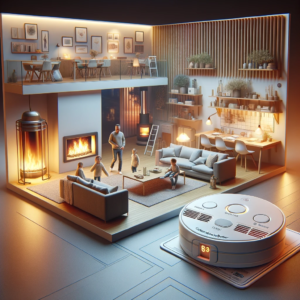Carbon Monoxide Safety During Heating Season: A Critical Guide
 As heaters begin to hum in homes, the risk of carbon monoxide (CO) poisoning, an invisible but deadly threat, significantly rises.
As heaters begin to hum in homes, the risk of carbon monoxide (CO) poisoning, an invisible but deadly threat, significantly rises.
This content aims to educate homeowners about the dangers of carbon monoxide during the heating season and the importance of having CO detectors in homes, especially when using gas furnaces or heating systems.
Understanding Carbon Monoxide
Carbon monoxide is a colorless, odorless, and tasteless gas produced by the incomplete combustion of fuels such as natural gas, propane, oil, wood, and coal. Common sources of CO in homes include gas furnaces, water heaters, fireplaces, and any gas-powered appliances.
The insidious nature of CO is that it can accumulate indoors without any noticeable signs. Prolonged exposure, even at low levels, can be harmful, and high levels can be lethal within minutes.
Symptoms of CO Poisoning
Recognizing the symptoms of CO poisoning can save lives.
Early symptoms often resemble the flu but without fever and can include:
- Headache
- Fatigue
- Shortness of breath
- Nausea
- Dizziness
Higher levels of CO exposure can lead to confusion, vomiting, loss of muscular coordination, loss of consciousness, and ultimately, death.
Prevention and Detection
The key to preventing CO poisoning is awareness and proactive measures. Here are some essential steps:
- Install Carbon Monoxide Detectors: CO detectors are lifesavers. They should be installed on every level of your home, especially near sleeping areas. Test them regularly and replace batteries at least once a year.
- Regular HVAC Maintenance: Ensure your heating system, water heater, and any other gas, oil, or coal-burning appliances are serviced annually by a qualified technician like those at Jacobs and Rhodes.
- Safe Usage of Appliances: Never use a gas stove or oven for heating. Portable gas camp stoves, generators, and charcoal grills should only be used outdoors and away from windows.
- Ventilation: Ensure proper ventilation in your home. Never block exhaust vents for your stove or heating system, as it can lead to CO buildup.
Choosing the Right CO Detector
When selecting a CO detector, consider the following:
- Type: Opt for detectors that meet UL Standard 2034 or IAS 6-96 standards.
- Features: Some models offer digital readouts, battery backup, and smart home integration.
- Installation: Place detectors high on walls or ceilings as CO mixes with air. Avoid placing them near windows or doors where drafts might skew readings.
Emergency Response
If your CO detector sounds:
- Immediate Evacuation: Evacuate all occupants immediately and ensure they are accounted for.
- Call for Help: Once outside, call emergency services.
- Do Not Re-enter: Do not go back inside until professionals have given the all-clear.
Conclusion
Carbon monoxide poisoning is a serious threat, but with the right knowledge and tools, it’s preventable.
Remember, a well-maintained heating system, properly installed and maintained CO detectors, and awareness of CO risks can make all the difference.
FAQs Section
To further assist our readers, here are some frequently asked questions about carbon monoxide safety:
Q: How often should I replace my CO detector?
A: CO detectors have a limited life span, typically between 5 to 7 years. Check the manufacturer’s recommendations and replace them when necessary.
Q: Can CO detectors also detect smoke?
A: Some detectors are combination units that can detect both smoke and CO. However, it’s essential to ensure that they meet the standards for both smoke and CO detection.
Q: Is it necessary to have a CO detector if I only use electric appliances?
A: While electric appliances do not produce CO, it’s still recommended to have CO detectors as a safety precaution, especially if you have an attached garage where vehicles could accidentally contribute to CO buildup.
Q: How can I ensure the safety of my elderly family members or those with hearing impairments?
A: Consider detectors with strobe lights or vibration features to alert those who might not hear the standard alarm sound.
Q: Are there any additional tips for maintaining my gas furnace safely?
A: Yes, ensure that your furnace’s filters are regularly changed and that the area around the furnace is clear of flammable materials.

 Jacobs and Rhodes
Jacobs and Rhodes Jacobs and Rhodes
Jacobs and Rhodes